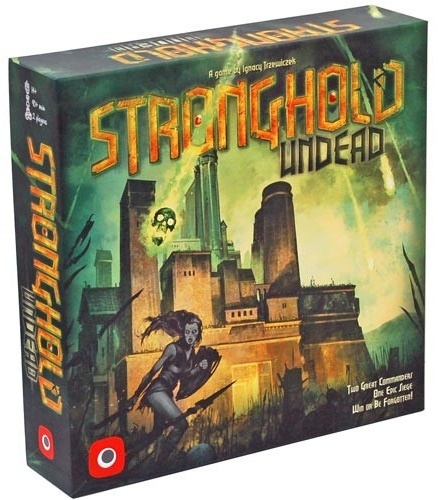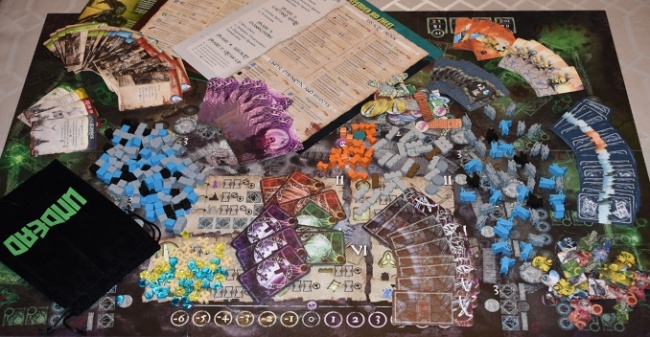Stronghold: Undead (Regular Edition)
Publisher: Portal Games and Stronghold Games
Designer: Ignacy Trzewiczek
Release Date: August, 2021
MSRP: $79.99
Number of Players: 2
Playing Time: 90+ minutes
Product #: SG-7120
Age Rating: 14 and up
ICv2 Rating: 3.5 Stars out of 5
I remember being at the Spiel game fair in Essen, Germany in 2009. A little-known company from Poland was pushing their new title. Their rather sizable demo area was packed edge to edge, and people were standing in line for a chance to try it out. The company was Portal Games, and the game was Stronghold. The next year, they introduced undead to the game as an expansion set. Now, nearly a dozen years later, Stronghold: Undead erupts from the grave again, this time as a stand-alone game with streamlined mechanics and expanded strategy options. But is its resurrection warranted, or does it belong in a moldy grave?
Summary: The game recreates an iconic fantasy scene: a lonely fortress under siege from an uncountable horde of monstrous foes. One player takes command of the defenders, desperately hoping to hold out until sunrise obliterates the deathless army attacking them. The other becomes the necromancer Arkhton, commanding the massive force of unliving warriors. Over eight rounds of play, the attacker gathers mana, casts magic spells, and maneuvers their phantoms, skeletons, and vampires in an effort to breach the walls of the fortress. The defender’s main resource in the game is time itself, and every action the attacker takes gives the defender a little bit more of this precious resource to construct and deploy their defenses to try to stop the assault.
Originality: The most interesting feature of Stronghold: Undead is that interplay between the two sides: The attacker can exert a strong assault, but doing so gives the defender more resources. But, being stingy with their resources could mean that their assault is too weak to overcome the defender’s resistance. On the other side, the defender could invest their time in building powerful weapons like cannons and vampire-piercing crossbows, but if they don’t save enough time to deploy the fortress defenders properly, the attacker will find a weak point and push through.
Presentation: The appearance of the game is very thematic, with a sickly-green and gold color palette and menacing typeface for title and descriptive text on the box. The style carries through inside the box as well, which is a bit of a mixed bag, unfortunately. The dark, brooding colors of the game board capture the feel very well, but in some places it is difficult to read important information like unit limits in some of the spaces. The tokens are all language-free, which is good, but in some cases it’s hard to determine which token refers to which siege engine or magical effect.
Quality: The wooden pieces are great: Little soldiers of various types, cross-bone tokens and castle wall blocks, even little hourglasses to represent time. Plastic gemstones of two types offer a colorful way to track magical resources, while cleverly-shaped tokens match the spaces on the board so it’s easy to know where they can be played. I also really like the way the game setup is designed to guide players through the steps of each round, helping things move along. A nice velvet bag emblazoned “Undead” is a classy way to randomize the attacker’s forces, and the playing cards are good quality.
But, the tiles are thinner than I have come to expect, and the choice of which components are wood and which are cardboard seems a bit random in places. The rulebook is printed on good stock, with lots of excellent illustrations, but they made the unfortunate choice of putting a lot of the rules on the two player aids rather than in the rulebook, which makes the game harder to learn than it should be. And when a question comes up during play, it is even harder to figure out where to find the answer. I’m also pretty sure I don’t like being reminded multiple times that I’m not playing the (improved) Kickstarter version.
Marketability: The biggest obstacle I see for Stronghold: Undead is its player count: exclusively for two players. While social distancing does mean that a people have more opportunities for one-on-one gaming, it’s not a great choice for more social gamers looking for group activities. On the plus side, the game comes with a lot of cool bits, with dozens of tokens and cards, 45 plastic gems, 130 wooden attacker cubes, and 41 wooden soldier “meeples.” The box has a gratifying heft to it to justify the price tag.
Overall: Stronghold: Undead is a very tight, competitive game, with a limited role for luck. Every decision is meaningful, if not decisive, and the side that makes the most, largest errors is going to lose. At the start, things seem easy for the defender, blessed with what feels like plenty of time, but the never-ending waves of attackers quickly dispel that illusion. The attacker’s force grows, but at the same time their supply of mana for spells quickly fades to a trickle, driving them to press the attack quickly. The effect is a very tense game, with a result that is uncertain until the very end. The learning curve, though, is very steep, especially for the defender who has a wide variety of very specialized abilities that need to be used effectively at the right time. The attacker is very much in the driver’s seat, and the defender can literally only react to what the attacker does, and only with the limited resources that the attacker allows them to have. The split rulebook/player aid presentation doesn’t help with the learning process much, but fortunately the mechanics are relatively straightforward and after a game or two (preferably as both sides) everything should be clear.
If you are looking for a light, easy-to-learn and fast-playing casual game for a group, Stronghold: Undead is not it. But if you want a very precisely designed one-on-one strategy game with minimal “luck factor,” this is an excellent option once you overcome the limitations of the rulebook and the less-than-helpful graphic design. And that’s why I’m giving this game 3.5 out of 5.
– William Niebling
Source: ICv2




